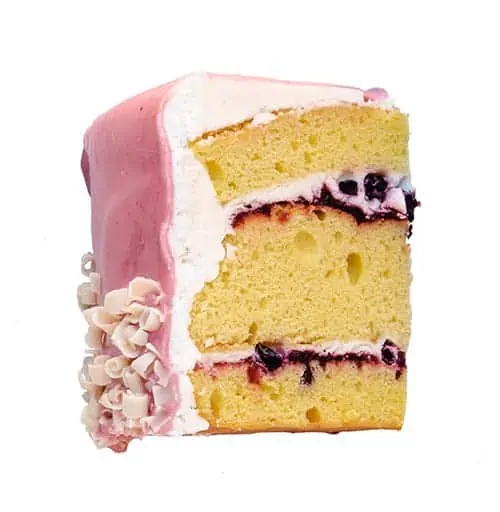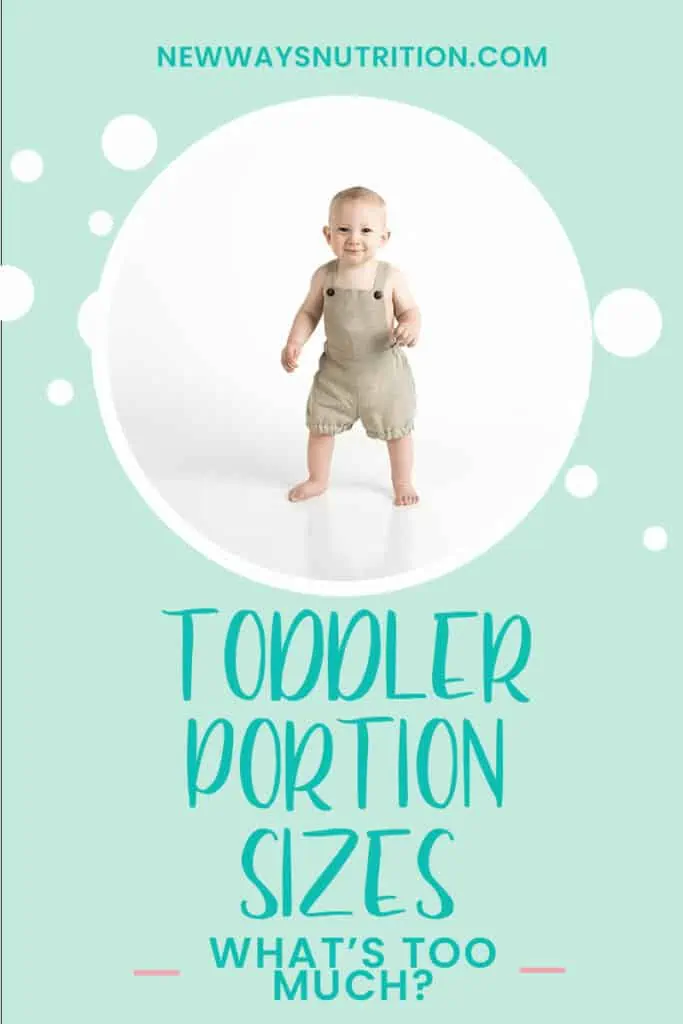What are the right food portions for your baby? Do you need to know toddler portion sizes? And can you ever serve them too much? Keep reading for the answers!
Portion sizes for toddlers, and kids in general, are a source of constant concern for many parents. If you do any type of search online, you’ll come up with all sorts of answers about what the correct portion sizes are for your toddler. There’s portion sizes for all the different food groups! From whole grains, to meat, and fruits and veggies. Really, for anything you can think of.
Quite frankly, it can be a lot to remember and just get downright confusing! So when it comes down to feeding your family, I like to recommend throwing worry about the appropriate portion size out the window.
Doing Away with Portion Sizes for Kids
Portion sizes, by nature, imply that we know better about how much a child should eat than they do. And that is exactly the type of thinking that leads to battles for control.
That means tantrums, anxiety about how much your child is eating, your child wanting more food than you want to give them, and can even lead to eating disorders later in life.
I know that all sounds drastic, but when we try to control how much our children are eating, that is what results. When it comes down to it, the only one that knows how much your toddler should eat at any given time is your toddler!
When it comes down to it, the only one that knows how much your toddler should eat at any given time is your toddler!
Toddler portion sizes are just averages to start with.
They are a combination of statistics and average serving size that don’t really take into account the needs of any one child. They cause a lot more concern in parents than help, in my professional opinion.
Young children have varied appetites. One day they might eat so much food, the next day what seems like almost nothing. Some kids thrive on what seems like not a lot of calories. Others need a ton to keep up with their body's demands and activity level.
If we rely on generalized recommended serving sizes for our toddlers, we are dialing those differences down. We're lumping everyone into one group with one set of needs. That's just not a great way to help babies, toddlers, or parents! There really is no right amount of food!
What Do We Do Instead of Portion Sizes?
It’s important to shift our mindset away from “getting" our kids to eat anything, first and foremost. It’s our job to decide the when and what when it comes to feeding. It is our children’s job to decide how much, and whether, they will eat.
A part of deciding the “what” aspect of feeding includes serving nutritious food. If we’re always serving foods that are not very nutrient dense, or that we know our child will eat a ton of and leave everything else behind, then we aren’t holding up our part of the bargain.
We need to be serving food that is nutrient-rich as well as a varied diet. Familiar food that they might eat a lot of to make sure they get enough calories, but also foods that we know have important nutrients for them, and new foods to help them expand their familiarity with them.
When we get this part down, it naturally reduces the stress that comes from them eating what we think is too much of something, or too little.
The Case of Fruit
Take fruit for example. I’m constantly being asked by parents if there’s such a thing as too much fruit. Or if they should be worried when their kid eats a ton of it. This is a great example of a nutrient-rich food, so serving it is already half the battle! But now comes the other part of the battle, variety.

If your child eats fruit ahead of all other foods, and will leave everything else behind when it is served, then it’s a good idea to think about not serving fruit at every meal. Maybe serve a vegetable or other nutrient-rich food in its place.
Not serving it helps to expose them to a variety of foods. It also gets them beyond eating just one thing at a meal. And while no one example will work for everyone, or solve all of your feeding problems, it’s a good rule of thumb and an example of how to start rethinking meal times.
By choosing to exert our control with the what of feeding, instead of the how much, we’re providing structure with a variety of foods that are primarily nutrient-rich. Once we get that part handled, feeding is out of our control.
The Logistics of Serving Sizes for Toddlers
With that being said, we still have to get food on the plate. That means we need to know where to start.
In general, I recommend serving family style as early as possible to help with toddler portion sizes. By teaching your child to serve themselves, you let them control how much they put on their plate. And be it a little or a lot of something, that is perfectly ok!
We want to encourage them to make these decisions for themselves. We're teaching them to listen to their own appetite. Because remember, our job is to get the food on the table. We decide what there is on offer. They decide how much of it to take, even if it’s none.

If you have a baby or very young toddler, they obviously can’t serve themselves! So in this case, I recommend starter portions of one or two pieces of two to three different types of food. Think smaller portions close to a tablespoon size for this if you are serving cut or scoopable foods. Head here for details on the categories that I recommend using to create a balanced meal.
Then have a side plate with extra of each type of food that you can replenish their plate from. Serving too much at one time can overwhelm kids, and especially babies. Starting small with small portions, and then being prepared to give them more until they decide to stop, is the best way to handle things.
Serving Sizes for Out of the House
When you're out and about and need to have food prepared ahead of time for them, you obviously won't be able to serve food family style. For instances like this, err on the side of giving your child larger portions than you think they'll eat.
If they normally eat 2 slices of something, give them three. If they've never had something before and you're just exposing them to it, give them a tablespoon even though they might not even touch it.
As you serve more and more meals or snacks outside of the house, you'll start to get used to what your child eats by the amount that is left in the container. It's okay to tailor the amount you offer to what your child normally eats! And if they eat everything that you sent, it's ok to send more next time! Especially if they aren't old enough to tell you whether they were still hungry or not.
But tailoring how much you send doesn't mean not serving something if you don't think that they will eat it. It's important to expose your child to different foods and give them the chance to eat them.
When Toddlers Eat a Lot of Something
If you serve something like eggs that your baby has been known to eat several of in one setting, that is again, perfectly ok. Where you should focus your control is not on how many eggs they eat at one meal, but how often you serve eggs to them! If they’re eating several eggs in one go, you might spread out how often you serve them eggs. This gives them a chance to get in other foods to their diet.
What to Do About Dessert
The topic of dessert deserves an entire post on its own. So I won’t get into detail about all of the intricacies that come with dessert. What I will say is that when it comes to something like dessert for toddlers, it is generally ok to limit portion sizes. But keep in mind a few things if you do.

Dessert doesn't have to be sugar laden! There are many different things that we can consider dessert, but we do want to be limiting or avoiding added sugar for toddlers under two. Beyond that, we don’t want dessert to be a forbidden food. As when you tell a child (or anyone) that they can’t have something it just makes them want it more.
When you serve dessert, don’t serve only a very small tasting portion because you don’t want them to have too much sugar. Let them enjoy it, and eat a normal size portion if they want. And don’t make them eat other food in order to get it.
Serve it with dinner, or serve it completely separate from dinner at snacktime. But don’t link getting dessert to eating anything else. It makes kids assume that the other food is less desirable. If you have to eat something to get some dessert, that food you have to eat automatically becomes something you just have to get through.
That does nothing for our children’s long term relationship with that food!
Taking Dessert off of It's Pedestal
Dessert can be delicious, and it’s important that we don’t introduce any shame around enjoying it. Remember, we want the basis of our mealtimes to be that we control the food based on when we serve it, not how much our kids eat!
Most people will find that when they take dessert off of a pedestal, children become used to it as a normal food, and won’t always choose it over other foods. They tend to take bites of it while going back and forth between other foods (even veggies!), and it loses its ability to hold them enthralled. Which is our end goal to begin with!
Let's Switch Our Thinking with Portion Sizes
Bottom line? We need to switch our thinking away from how much our kids should be eating. Or getting our kids to eat something. It is not our job to determine how much our kids eat. It’s our job to determine what gets put on the table! When we start thinking about how much they should eat, what is a normal portion size, what is their overall intake and are they eating too much or too little compared to what's "normal", that’s when we get into trouble.
Parenting is full of enough anxiety, let’s not add to it with unnecessary attempts to control how much our kids eat.
Get the toddler course
Mastering Mealtimes
From how to set up mealtimes so they aren't stressful, to how to quickly and easily get food on the table that meets all their needs. Grab the course to set your toddler's relationship with food up for life!

